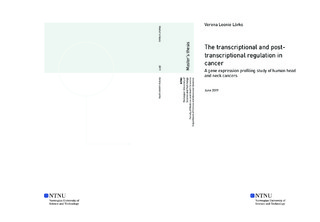| dc.description.abstract | Head and neck squamous cell carcinomas are a collection of tumors that arise from mucosal cells in the oral cavity and the upper airway and food passages. Despite their common mucosal origin, the group of HNSCCs is rather heterogeneous. Human papillomavirus (HPV) has emerged as the driving force of a subset of these malignancies. HPV positive and HPV negative HNSCCs largely differ in epidemiological, clinical and molecular features and are perceived as two different entities of the disease. Numerous studies have attempted to shed light on the transcriptional profiles of head and neck cancer, however, the field of HPV-related gene expression signatures in HNSCC is still evolving.
In this study, we highlight the differences in the coding and non-coding transcriptome of HPV+ and HPV- HNSCC. We utilized RNA sequencing data from six different HNSCC cell lines to confirm HPV status as the main driver of transcriptional differences. Subsequently, we mapped out the differentially expressed genes in HPV+ and HPV- cell lines with and without a normal control cell line. We also detected differential expression in HPV negative (n=162) and HPV positive (n=32) tumor samples from the TCGA database and compared the results to our findings from the HNSCC cell line dataset. The differences in gene expression were validated by qPCR in a subset of genes. The function of DE protein coding genes was assessed by GO Molecular Function overrepresentation analysis.
We identified n=154 coding and n=10 non-coding differentially expressed genes between HPV+ and HPV- groups across both datasets. A fraction of the identified differentially expressed non-coding transcripts has previously been linked to HNSCC or other cancer types. Among the protein coding differentially expressed genes, we found an enrichment of serine proteases, aldo-keto reductases and cytokines among others.
In sum, this work has contributed to elaborate the transcriptional profiles of HPV+ and HPV- head and neck cancer. We identified several non-coding genes that had not been linked to HPV-related subtypes of head and neck cancer so far. We were able to identify a set of differentially expressed coding genes and annotated their molecular function. Our contribution to the mapping of non-coding transcriptional profiles in HPV-related head and neck cancers may be valuable with respect to the identification of new biomarkers for HNSCC. | |
